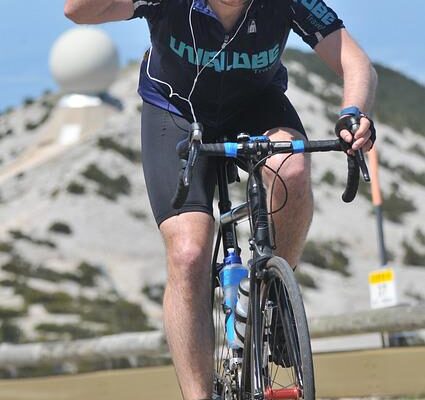Whether you are getting into cycling or have been cycling, there’s an outdoor riding workout to suit your abilities. At each level, here’s where to begin.
Outdoor cycling is a type of aerobic activity that, among other things, can enhance cardiovascular function, resting heart rate, and blood pressure. If that isn’t enough to get you to hop on your bike, the sport also creates a connection with nature and is associated with improved mental health and well-being.
Outdoor Cycling Workout for Beginners
If you’re a rookie on the bike, start slowly and steadily as you gain confidence in cycling outside. A few relaxing rides before embarking on more strenuous training will help you improve your bike handling and control.
The best recommendation for new riders is to not follow any exercise plans at all. Those who are just starting out will experience the largest initial boost in performance by simply riding more. Experts recommend that beginning riders spend at least 4 to 6 hours each week, spread out over several weeks, just ‘free-riding” on the bike. Discover new roads in your city or town, and consider joining a bike group or club. Your fitness will increase while you maintain your enjoyment of cycling.
New riders should not try to accomplish too much too quickly. Building cardiovascular fitness and muscle endurance takes time. Doing too much right away might result in burnout, overtraining syndrome, overuse injuries, and weariness.
Rather, the goal for beginner cyclists should be to have fun, ride safely, master fundamental bike handling skills, and establish a fitness foundation. As your aerobic endurance and strength improve, you might consider developing a training regimen.
Before you decide to get on a bicycle, make sure you have a well-fitted helmet and a bottle of water on hand. You should also avoid cycling in extreme heat or cold and avoid cycling at night when others are less likely to notice you.
Workout for Beginners
When you’re ready to begin a training regimen, start with three rides per week, each lasting around 30 minutes and being moderately intense, before gradually increasing to four to five rides per week.
Those who have substantial cardiovascular exercise experience, such as running, rowing, or other endurance sports, may be able to grow faster than those who do not.
Example of a beginner cycling routine that you can undertake when you’re ready
- Warm up for 5 to 10 minutes with a mild effort and a moderate leg speed (cadence). (You should not be feeling short of breath.)
- To gauge your intensity, use the conversation test or perceived exertion.
- Cycling at a moderate intensity for 20 to 25 minutes raises your pedaling speed to a quicker pace and with more physical exertion. (As your workout becomes more strenuous, you should enter a higher heart rate zone.)
- Cool down for 5 minutes with an easy spin, lowering your heart rate with gentle exercise.
Gradually increase the length for the first six to eight weeks until you can ride for an hour at a moderate intensity—only then should you consider increasing the challenge.
Workout for Intermediate Outdoor Cycling
Consider increasing the workout intensity for a more challenging outdoor cycle as you gain confidence on the bike. The fact that the workout is becoming simpler with each repetition indicates that you are ready. The same safety precautions apply to beginners.
Intermediate cyclists should be able to signal with either hand, drink from a water bottle, and eat while riding.
Example of an intermediate cycling routine that you could try
When you reach this level, you can continue to measure intensity with heart rate and exercise effort or perceived exertion.
- Warm up by spinning for 5 to 10 minutes at a moderate cadence and with little physical exertion.
- Increase your pedaling speed from the warmup to the point where you are breathing quicker but not out of breath.
- Maintain moderate-intensity aerobic endurance for 15 to 20 minutes.
- Find a hill that you can climb for at least 6 to 8 minutes in order to complete climbing repeats.
- Begin slowly for the first minute and progressively increase the intensity.
- After 5 minutes of easy spinning and light exertion, repeat the climb.
- Finish with a 5 to 10-minute easy cycle cooldown.
Begin with one session each week of three to five climbing repetitions, gradually increasing to five to six climbing repetitions.
Workout for Advanced Outdoor Cycling
Depending on their training plan and goals, advanced cyclists will wish to extend the length of their bike ride. If you are preparing for a specialized cycling event, such as a Gran Fondo, or a multi-sport event, such as a triathlon, your weekly riding output will be significantly higher than when you are pedaling during your off-season.
Option 1 for Advanced Workout
- Warm up for about 10 minutes by easy spinning at a slow speed and without straining.
- Spend 15 to 20 minutes at a moderate pace, gradually increasing your bike speed and workout exertion.
- Perform two sets of 5 x 2-minute VO2 Max sprints, pushing your bike pace to a high level of physical effort.
- Relax for 3 minutes with a gentle spin.
- Finish with a 10-minute moderate-effort cycling interval between VO2 Max sets.
- Finish with a 5 to 10-minute low-effort cooldown.
Build up to this workout as a three-week progressive series, beginning with two workouts per week with these timings and gradually increasing the VO2 Max sprints to two sets of six minutes each.
Option 2 for Advanced Workout
- Begin the ride by warming up for 30 minutes with an easy spin.
- Then, for 30 minutes, do tempo or a more severe aerobic exercise where conversing is more difficult.
- Perform a 1-minute burst at VO2 Max or “full gas.”
- Repeat every 5 minutes until the 30-minute block is finished. (You will perform five tempo bursts in total.)
- Relax for 15 minutes with a gentle spin.
- Repeat twice more for a total of 1 1/2 hours of tempo bursts, recuperating as instructed between each block.
- Relax for 30 minutes with a gentle spin.
Cycling Suggestions
Before you get on your bike, consider your cycling experience and ability. Make sure your equipment is properly-suited and that you stick to well-marked bike paths or trails.
Warm up your muscles before launching full speed into the workout, and stretch at the end—perhaps with an alternated yoga session during the week—to prime and repair your body from the workout intensity.
Stretching and connecting with your breath through yoga, as well as focusing on a nutrient-rich diet (particularly if preparing for a triathlon), will better prepare you for outdoor cycling sessions. Remember, nutrition only allows you to work as hard as your fuel, with more calories required as you increase the intensity.
Always bring water and food. Preferably something carbohydrate-rich like a granola bar, banana, or even specialized carbohydrate gels.


Carbohydrates are the first fuel source your body will burn to maintain vigorous activity, so replenishing these stockpiles is critical to a good workout.
Aside from diet, a variety of lifestyle factors can increase your cycling performance and endurance. Cross-training with resistance workouts, for example, can build your strength, improve motivation, and keep you from becoming bored with the same program.
To Conclude
Outdoor riding could provide you with the challenge you need to improve your physical fitness. Outdoor cycling is a popular sport that allows you to connect with nature while also building endurance and strength (particularly in the lower body).
Keep in mind that cycling exercises like these are usually examples rather than prescriptions, which means they are not one-size-fits-all. Listen to your body as well as licensed sports and health specialists, and make adjustments to fit your riding goals and level. Lastly, you should be able to “speak” comfortably in short sentences during moderate aerobic exercise, but as your exercise intensity increases, it gets more difficult to talk. As a novice, it is recommended to keep the majority of your effort at a level where you can chat easily in short words throughout the exercise.



